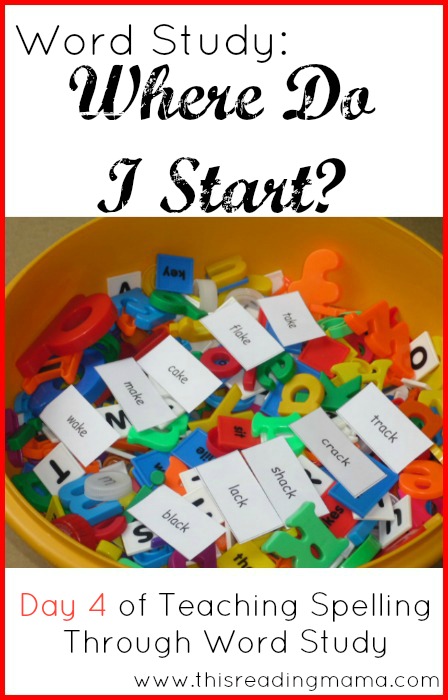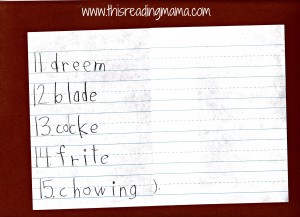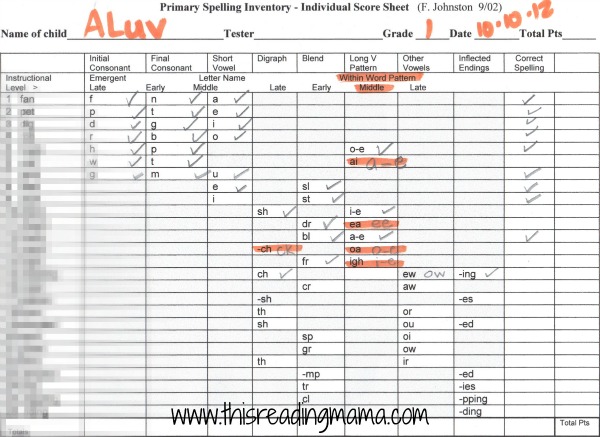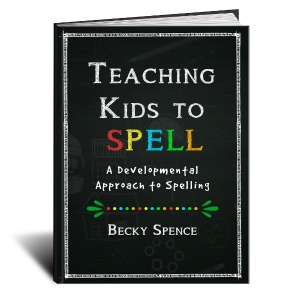 *This post contains affiliate links. Please read my full disclosure policy for more info.
*This post contains affiliate links. Please read my full disclosure policy for more info.
We’re on Day 4 of a 10 day series on Teaching Spelling Through Word Study, a collaborative blogging series with iHomeschool Network. If you missed days 1-3, you can click HERE or on the image above to see the topics and links. So far, we’ve talked mostly background theory, it will help you with what we’ll explore today: Where Do I Start Spelling Instruction?
Okay, you understand the benefits of teaching spelling with word study, but you’re unsure where to start your spelling instruction. You know you want to start on your child’s instructional level. But WHAT IS YOUR CHILD’S INSTRUCTIONAL LEVEL? I’m going to show you two kinds of assessments that can help you find it.
Developmental Spelling Inventory
The first is from Words Their Way. You can find links to this assessment (as well as other Words Their Way assessments) here. I used the Primary Spelling Inventory with my child to demonstrate, which is designed for Kindergarten through 3rd graders (You could also use the Elementary or Upper-Level Spelling Inventories, depending on the age/development on your child).
The words on the inventories are specifically chosen to display the child’s knowledge and understanding of certain spelling features (short vowels, long vowels, blends, etc.) The words begin at a rather “easy” level and gradually become more difficult to spell. It is administered in a similar fashion as a spelling test, except this child has not studied these specific words beforehand.
If you have a child who gets “hung up” in spelling words correctly, you may want to prep your child by telling him upfront that he’s not going to know how to spell all of the words correctly…and THAT’S OKAY! He just needs spells each to the best of his ability and write down all the sounds he hears.
To administer the assessment, I read him one word at a time, used it in a sentence, and he spelled each word. When I noticed that he had misspelled three words in a row, I stopped because I knew that the patterns were only going to get harder and I didn’t want frustration to kick in.
Scoring a Spelling Inventory
 I took his results and recorded them on the Individual Score Sheet, as seen below. This sheet can be found in Words Their Way. Note that each column has different spelling features: Initial Consonant, Final Consonant, etc. Where he spelled a feature correctly, I check beside it in each column. I also checked “Correct Spelling” in the last column if he spelled the word totally right.
I took his results and recorded them on the Individual Score Sheet, as seen below. This sheet can be found in Words Their Way. Note that each column has different spelling features: Initial Consonant, Final Consonant, etc. Where he spelled a feature correctly, I check beside it in each column. I also checked “Correct Spelling” in the last column if he spelled the word totally right.
 When he misspelled a word, like # 6 when he spelled WATE for wait, I wrote his incorrect spelling pattern (A_E) beside the correct one (ai). After I recorded all the information, I went back with a highlighter and highlighted all his misspellings so they would “jump out” at me.
When he misspelled a word, like # 6 when he spelled WATE for wait, I wrote his incorrect spelling pattern (A_E) beside the correct one (ai). After I recorded all the information, I went back with a highlighter and highlighted all his misspellings so they would “jump out” at me.
Now, not all students’ levels are this clear-cut, but I can clearly see from this assessment that he needs to do some more work on Long Vowel Patterns. This is his instructional level. And directly under “Long V Patterns” I can see that he is in the Middle of the Within Word Pattern Stage. If your child’s scores aren’t this clear-cut, a good rule of thumb is to start spelling instruction in the column where the child missed 2 or more of a particular feature.
Pre Test/Post Test Format
Spelling Mechanics Homeschool Word Study program has another way for you to figure out the level of your speller and is very similar to a spelling inventory: Pre and Post tests.
Let’s say my child is in the third grade and I know he’s a struggling speller (he’s not spelling or reading on a 3rd grade level). Spelling Mechanics would suggest that I give him the level 2 pretest, remembering that the goal is NOT a perfect score. His misspellings are where I’m going to learn the most about his level of word understanding!
After scoring his tests, this is how I’d determine his instructional level (the level at which I should start teaching):
- If he scores about 45% – 70% correct then I’d start on level 2 and use the Level “B” word sorts (Level “B” means on grade level).
- If he score below 45% I’d start with level 2 and use the level “A” word sorts (Level “A” sorts are below grade level).
- If he scores between 70% – 90% let’s start with Level 2 and use the word sorts marked “C”. These words are a bit more difficult (Level “C” sorts are above grade level).
- If he surprised me and got a perfect score, I wouldn’t waste my time with Level 2. He understands the rules of spelling and needs a challenge. Let’s go into Level 3.
Observe Spellings in Independent Writing
Another more informal idea of figuring out your child’s level of spelling development is to pick up pieces of his independent writing {independent is key} and analyzing his spellings and misspellings from within the context of his writing. While this may seem intimidating, in my ebook, Teaching Kids to Spell: A Developmental Approach to Spelling, I have a printable chart with full explanations on how to do this in the appendix.
More Spelling Resources:
~Becky


The best thing about this is the hands on approach!
Yes, that is one of my favorite things, too.
I love this! I love the whole approach and reasoning. It just makes sense. This is what I used when I taught school, but have struggled in doing with my own kids for some reason.
After I determine where to start the spelling instruction for a particular student, where do I find the list of words for sorting? Do I make up one & how do I go about doing that? I’m completely new at this – 1st time homeschooling and I want to help my struggling speller!
I use the word sorts from the WTW supplement books. They have a book for each stage of spelling development. You can find them on Amazon.
Thank you for solving my problems